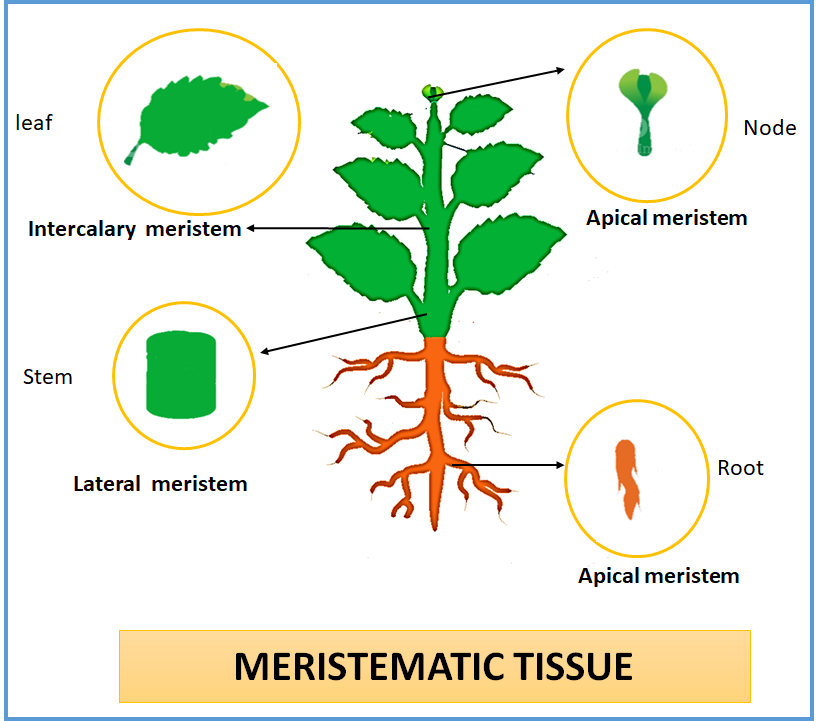
Why do meristematic cells have a prominent nucleus and dense cytoplasm but they lack vacuole?
(a) No need for storage
(b) No space for vacuole
(c) Cells cannot divide possessing vacuoles
(d) None of the above
Answer
576.9k+ views
Hint: Meristematic cells are a special type of cell that is in a continuous phase of division resulting in a new set of cells or retains the power of division. Cell division is an energy-expensive process, requiring a constant breakdown of glucose to release ATP or energy.
Complete answer:
Meristematic cells are thin-walled cells with rich cytoplasm and a big nucleus. Vacuoles are non-cytoplasmic areas separated from the cytoplasm by specific membranes. Their primary function is to reserve food materials which are excess for future use. But as meristematic cells are in a constant phase of division and thus require energy or ATP. This is fulfilled by constantly breaking down glucose, leaving little or no excess food to store. This explains why they lack vacuole and their respiration rate is also high.
Additional Information:
Meristems are of two types- primary and secondary meristems, based on their origin. Primary meristems develop directly from the embryo tissues. Secondary meristems develop from the permanent tissue which has acquired the power of division.
Based on the location, meristems are classified into - apical meristem, intercalary meristem and lateral meristems.
Apical meristem: they are located at the tip of a growing shoot or root, be it their main axis or the tip of their lateral branches. They are devoid of vascular tissues and virus-free areas. Therefore, whenever a plant has been infected by any pathogen or virus, its apical meristem is cut off to grow another plant.
Intercalary meristem: It is located between the regions of permanent tissues. They are responsible for increasing the height of a plant. Therefore even at times when a stem breaks down due to strong wind, they resume their growth.
Lateral meristem: Their division increases the girth of a plant i.e increasing the diameter of a plant. Intrafascicular cambium is a type of lateral meristem. A set of actively dividing tissue occupies space between the vascular bundles (xylem and phloem).

So, the correct answer is ‘No need for storage’.
Note: -Any cell which loses the capacity to divide and acquire a permanent function, shape and size, they are known as permanent tissues. They may be simple permanent tissues or complex permanent tissue.
-Simple permanent tissues are made up of just one type of similar cells performing the same function e.g. parenchyma, collenchyma and sclerenchyma.
-Complex permanent tissues are made up of more than one type of cells and work as a unit to perform the same function. E.g. xylem and phloem.
Complete answer:
Meristematic cells are thin-walled cells with rich cytoplasm and a big nucleus. Vacuoles are non-cytoplasmic areas separated from the cytoplasm by specific membranes. Their primary function is to reserve food materials which are excess for future use. But as meristematic cells are in a constant phase of division and thus require energy or ATP. This is fulfilled by constantly breaking down glucose, leaving little or no excess food to store. This explains why they lack vacuole and their respiration rate is also high.
Additional Information:
Meristems are of two types- primary and secondary meristems, based on their origin. Primary meristems develop directly from the embryo tissues. Secondary meristems develop from the permanent tissue which has acquired the power of division.
Based on the location, meristems are classified into - apical meristem, intercalary meristem and lateral meristems.
Apical meristem: they are located at the tip of a growing shoot or root, be it their main axis or the tip of their lateral branches. They are devoid of vascular tissues and virus-free areas. Therefore, whenever a plant has been infected by any pathogen or virus, its apical meristem is cut off to grow another plant.
Intercalary meristem: It is located between the regions of permanent tissues. They are responsible for increasing the height of a plant. Therefore even at times when a stem breaks down due to strong wind, they resume their growth.
Lateral meristem: Their division increases the girth of a plant i.e increasing the diameter of a plant. Intrafascicular cambium is a type of lateral meristem. A set of actively dividing tissue occupies space between the vascular bundles (xylem and phloem).

So, the correct answer is ‘No need for storage’.
Note: -Any cell which loses the capacity to divide and acquire a permanent function, shape and size, they are known as permanent tissues. They may be simple permanent tissues or complex permanent tissue.
-Simple permanent tissues are made up of just one type of similar cells performing the same function e.g. parenchyma, collenchyma and sclerenchyma.
-Complex permanent tissues are made up of more than one type of cells and work as a unit to perform the same function. E.g. xylem and phloem.
Recently Updated Pages
Master Class 12 Business Studies: Engaging Questions & Answers for Success

Master Class 12 Economics: Engaging Questions & Answers for Success

Master Class 12 English: Engaging Questions & Answers for Success

Master Class 12 Maths: Engaging Questions & Answers for Success

Master Class 12 Social Science: Engaging Questions & Answers for Success

Master Class 12 Chemistry: Engaging Questions & Answers for Success

Trending doubts
What is meant by exothermic and endothermic reactions class 11 chemistry CBSE

Which animal has three hearts class 11 biology CBSE

10 examples of friction in our daily life

One Metric ton is equal to kg A 10000 B 1000 C 100 class 11 physics CBSE

1 Quintal is equal to a 110 kg b 10 kg c 100kg d 1000 class 11 physics CBSE

Difference Between Prokaryotic Cells and Eukaryotic Cells




